
Overview
The Animal Rescue: Adopt a Shelter Pet sheet of commemorative stamps feature photographs of 10 sheltered pets — five cats and five dogs.
This sheet of stamps is part of the Postal Service’s long-term commitment to raising awareness of important social issues. The Animal Rescue: Adopt a Shelter Pet commemorative stamps raise awareness of the importance of adopting companion animals from shelters to help prevent the senseless euthanizing of millions of animals every year.
The promotion is called “Stamps to the Rescue.”
Unveiling: The Animal Rescue: Adopt a Shelter Pet stamps were unveiled on March 17, 2010, on the Ellen DeGeneres Show by Postmaster General Jack Potter and Ellen DeGeneres.
Promotion: The Postal Service™ launched its “Stamps to the Rescue” promotion in conjunction with the unveiling of the stamps.
First Day of Issuance: On April 30, Postmaster General Jack Potter and Ellen DeGeneres will dedicate the Animal Rescue: Adopt a Shelter Pet stamps at a 2 p.m. (PT) ceremony at the Academy of Television Arts & Sciences in Hollywood, California.
About the Stamps
n The commemorative stamps are called Animal Rescue: Adopt a Shelter Pet, and the green selvage includes the language “Featuring animals adopted from shelters”.
n This is the 2010 social awareness stamp subject.
n The 44-cent stamps will be sold in panes of 20 for $8.80.
n Three hundred million stamps will be printed — 15 million sheets.
n A print run for commemorative stamps averages 65 million total stamps — 4.5 times as many Adopt a Shelter Pet stamps have been printed than the average commemorative stamp.
n If the Postal Service sells 7.5 million sheets by the end of May, the stamps will be reprinted.
n A second printing, if necessary, will be 120 million stamps, or 6 million sheets.
n The goal is to have this sheet of commemorative stamps be the most pre-ordered stamp in history — possibly requiring a reprint before they are even available for sale.
n These stamps continue a 50+ year tradition of the Postal Service bringing attention and awareness to serious social issues of the day…one letter at a time.
n The stamps feature photographs of five cats and five dogs adopted from the same shelter: the Animal Rescue Society shelter located in New Milford, Connecticut.
n Sally Andersen-Bruce took the photographs on Memorial Day weekend in 2006.
n Derry Noyes is the designer and art director for the stamps.

About the “Stamps to the Rescue” Promotion
The 8-week ”Stamps to the Rescue“ promotion kicked off with the unveiling of the Animal Rescue: Adopt a Shelter Pet commemorative stamps on The Ellen DeGeneres Show March 17.
The Postal Service is working with Ellen DeGeneres and Halo: Purely for Pets — a pet food company that DeGeneres co-owns — on the national promotion of the Animal Rescue: Adopt a Shelter Pet commemorative stamps.
The Postal Service is excited to work with Ellen DeGeneres and Halo to increase public awareness of the stamps, to increase social awareness of the subject, and to introduce the Postal Service to a new audience. DeGeneres has a large, loyal following, and she is passionate about pet adoption. She has often addressed the subject on her show and in other public forums, including in social media.
Together we can encourage pet adoption and help to bring an end to the tragedy of adoptable, unwanted, homeless, and abandoned pets being euthanized each year.
The goal is to increase public awareness of the problem and to promote humane and responsible pet care.
n Halo will be donating 1 million meals to animal shelters across the country.
n Promotional posters and counter cards went up in all Postal Service retail lobbies nationwide and will remain there until May 14.
n The www.stampstotherescue.com microsite launched.
n Pre-ordering for the stamps began.
n The social media campaign began.
n An internal screensaver about the campaign will run from March 29 to April 11.
n The first day of issuance will be Friday, April 30, in Hollywood, California.
n A national cancellation, featuring the face of a dog and a cat, www.stampstotherescue.com, and Animal Rescue: Adopt a Shelter Pet, will run on mail processing equipment from April 30 through May 14.
n Local events will be held across the country.
What is “Stamps to the Rescue”?
“Stamps to the Rescue” is the name of the promotion the Postal Service created to support its 2010 social awareness stamps, Animal Rescue: Adopt a Shelter Pet — it’s the language on the collateral material in retail and it’s the URL for the special website that was launched when the stamps were unveiled on March 17.
How did Ellen DeGeneres and Halo get involved?
When the Postal Service issues a social awareness stamp, the goal is to generate awareness about the subject as much as possible. This year, the subject is Animal Rescue: Adopt a Shelter Pet, and the Postal Service wanted to work with individuals and organizations passionate about the subject that could assist in generating and increasing awareness nationwide. The Postal Service reached out to Halo, who, in turn, reached out to DeGeneres.
How is the Postal Service getting the message out about adopting shelter pets?
n The Postal Service is printing 300 million Animal Rescue: Adopt a Shelter Pet stamps — 15 million sheets — that will be sold nationwide.
n There will be posters and counter cards in every one of the nearly 33,000 postal-owned or, -leased retail locations across the country promoting the stamps and the relationship with DeGeneres and Halo.
n Information will be posted on the Postal Service’s website, usps.com® and a microsite specially created for this promotion: www.stampstotherescue.com. This microsite has information about the stamps, the animals on the stamps, and the importance of animal adoption. Customers can pre-order stamps and collectible products on these websites.
Who are the pets depicted in the stamps?
The stars of this promotion are 10 shelter pets, all successfully adopted by loving families through the Animal Welfare Society of New Milford, Connecticut. Each cat and dog has a unique story, which is posted on www.stampstotherescue.com.
Where can people go for more information about the promotion?
www.stampstotherescue.com
Microsite
www.stampstotherescue.com
This Postal Service microsite was launched in conjunction with the unveiling of the stamps and features information about the stamps, pet adoption, and the importance of spaying/neutering pets, as well as links to related sites, such as American Humane Association, Humane Society of the United States, and www.petfinder.com.
The site also features a “thermometer” on the left-hand side that will initially show cans of Halo pet food increasing as sheets of stamps are pre-ordered. Once the million-meal mark has been reached, the thermometer will continue to display how many sheets have been pre-ordered, then sold after April 30.
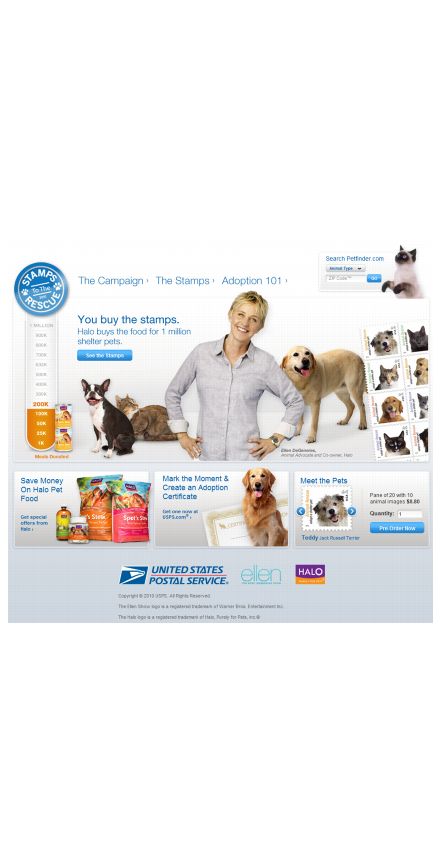
Retail Material
This promotional campaign features posters and counter cards in postal retail lobbies nationwide.
Poster — Up March 17 and Down May 14

Counter Card — Up March 17 and Down May 14
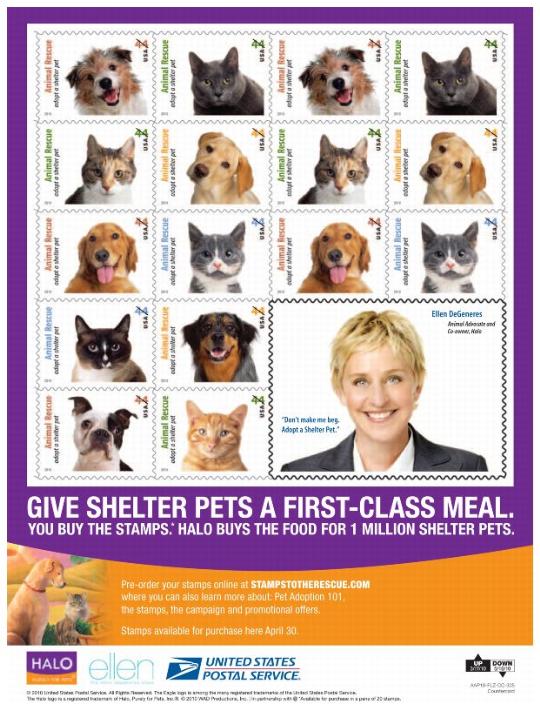
National Cancellation
In conjunction with the first day of issuance ceremony, this image will be used to cancel stamps on all automation equipment from April 30 through May 14.
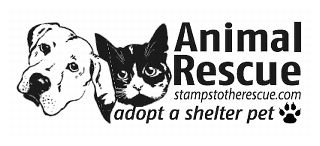
Community/Grassroots Promotions — Local Events and Publicity Ideas to Interest the Media
There are many ways to generate local media interest in the Animal Rescue: Adopt a Shelter Pet commemorative stamps.
The Postal Service will be working with the following organizations for the community relations portion of this campaign that will kick off on Saturday, May 1:
n American Humane Association.
n American Veterinary Medical Association.
n Humane Society of the United States.
n PetCo stores.
n Petfinder.com.
n PetSmart stores.
Stage a Kick-off Event
n Partner with a local shelter and host an “open house.” The Postal Service unveils the stamps, and the shelter has the opportunity to showcase not only pets, but its operation as well. Give tours. Provide snacks for humans and animals (a local pet supply retailer might be interested in donating something). Have animal control officers talk about their jobs. Hand out educational material to visitors — include what to expect when you adopt a cat or dog, tips for solving some common behavior problems, etc. Invite the local radio and TV stations to broadcast live.
n Get Postal Service representatives and retail clerks to attend existing events. As an example, PetCo and PetSmart locations around the country regularly host adoption fairs on site, and the stamps could be unveiled and sold there.
n Host an Information Fair. Unveil the Animal Rescue: Adopt a Shelter Pet stamps in the parking lot of a Post Office, station, or branch. Invite animal control officers, local veterinarians, and/or other animal services representatives to speak. Ask shelters to bring dogs and cats to encourage adoption. These types of events allow potential adopters to interact with the animals and sign up to adopt them on location.
n Conduct a pet food drive. When sending out information about the event, include language encouraging participants and customers to bring cat and/or dog food to donate to the local shelter.
Other Event Ideas
n Hold a poster or essay contest — with a theme of “the role of an animal shelter” or “responsible pet ownership” or even “the importance of spaying or neutering” — at a local elementary school a week before the above-mentioned open house. Then display all posters and essays. A committee of postal employees could choose the winners.
n Sponsor an essay-writing contest with the local schools (perhaps limit it to one grade such as sixth grade) on the subject of the importance of adopting shelter pets. Have the postmaster, a local veterinarian, the director of the local animal shelter, and a teacher judge the contest. Award a framed sheet of stamps or a blowup of the stamps to the winner.
n Sponsor an essay-writing and picture-drawing contest with local grade schools on “What My Pet Means to Me.” Hang some of the best essays and cutest drawings in local veterinarians’ offices and local animal shelters.
n Hold a pet and owner look-alike contest.
n Hold a celebrity pet look-alike contest.
n Hold a pet costume contest.
n Have a dog wash.
n Coordinate groups of children — children of postal employees, Boy Scout and Girl Scout troops, 4-H Clubs, etc. — to write letters to shelter animals to be published in the local paper to promote adoption.
n Sponsor a pet show with local 4-H Clubs, Boy and Girl Scouts, Boys and Girls Clubs, etc., with a special category and special prize for adopted shelter pets.
Implement any of these ideas, combine them, or create others. Contact your local Corporate Communications and Government Relations representatives for assistance. Find contact information on the last page of this kit.
About Social Awareness Stamps
The U.S. Postal Service® began issuing social awareness stamps in the 1950s. They’ve been issued on a regular basis since 1970 and have included a wide variety of social awareness subjects such as the following:
1980s
1990s
2000–Present
Past stamps that have included cats and/or dogs
n Spay and Neuter (2002).
n Bright Eyes (1998).
n American Cats (1988).
n American Dogs (1984).
n Puppy and Kitten (1982).
n Seeing For Me (1979).
Stamp Artwork
To obtain stamp enlargements, contact:
Victor Pulupa
Dodge Color
4827 Rugby Ave., Ste. 100
Bethesda, MD 20814-3028
Telephone: 240-247-1815
Animal Rescue: Adopt a Shelter Pet Station — Pictorial Cancellation Art
To finalize the Animal Rescue: Adopt a Shelter Pet station pictorial cancellation art, insert the date and the city, state, and ZIP™ Code of the physical location of your event where indicated.
The Postal Service must make all special postmarks known to collectors through advance publicity in the Postal Bulletin. Therefore, all special dedication cancellations must be reported to Stamp Services 2 weeks before the events using PS Form 413, Pictorial Postmark Announcement/Report. To get a copy of the form, go to http://blue.usps.gov/formmgmt/pt.htm.


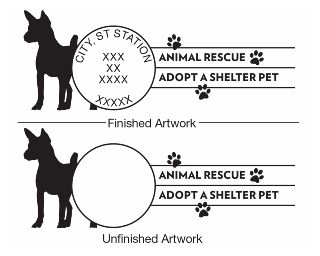
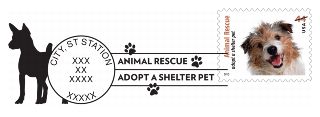
First Day of Issue Postmark
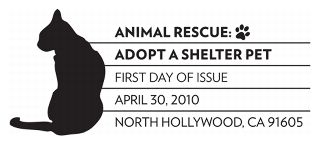

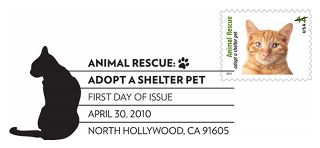
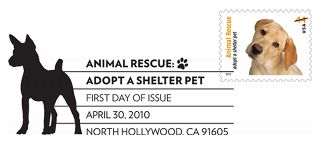
Digital Color Postmarks
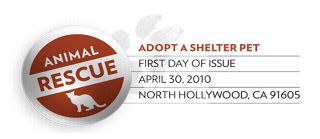
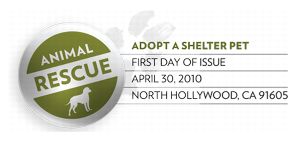


Philatelic and Retail Products

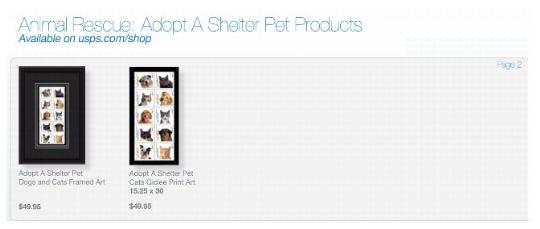
Animal Rescue: Adopt a Shelter Pet Certificate for Special Events
To support local offices conducting special events commemorating the issuance of the Animal Rescue: Adopt a Shelter Pet stamps, a downloadable “adoption” certificate has been created.
Postmasters are encouraged to download the certificate, print it on paper of appropriate stock (24 lb. or more), and make it available at no charge to customers who purchase the Animal Rescue: Adopt a Shelter Pet stamps at the event. The intent is to enable customers to affix their Animal Rescue: Adopt a Shelter Pet stamp(s) to the certificate and have the certificate postmarked at the local event. After customers have added their personal pet information, they will have created their own unique Animal Rescue: Adopt a Shelter Pet collectible keepsake.
To download the certificate, click here.
Licensed Products
Licensed merchandise featuring Animal Rescue: Adopt a Shelter Pet stamp images is available at
www.stampstotherescue.com.
Animal Rescue: Adopt a Shelter Pet Commemorative Stamps — Meet the Pets
Image
|
Name
|
Breed Or Color
|
Story
|

|
Teddy
|
Wire-haired Jack Russell Terrier
|
The owners of Teddy’s mother were surprised when she had the litter. They couldn’t own another pet, so they gave Teddy and his litter mates away.
|

|
Bianca
|
Calico
|
Bianca was adopted through a senior-to-senior program, which allows cats older than 6 years to be adopted by a senior citizen at no cost. (Bianca has since passed away, but was loved in her final years.)
|

|
Buddy
|
Golden
Retriever
|
Buddy is a purebred Golden Retriever who was purchased from a pet store.
He had bad hips, and the family that purchased him couldn’t care for him.
He was given to the shelter.
|

|
Frankie
|
Black, white, and tan with triangle on nose
|
Frankie was brought to the shelter with his mother and two litter mates. They were all very sick, and Frankie was the only one who survived.
|

|
Jake
|
Boston
Terrier
|
Jake was born in a puppy mill in Missouri. He was trucked to Connecticut and sold to a pet store. A family bought him, and after only 2 weeks decided it was too much work and gave him to the shelter.
|

|
Willow
|
Maltese
(Gray)
|
Willow was left in a box by the door of the shelter when she was small kitten. The animal control officer there adopted her.
|

|
Trevor
|
Labrador
Retriever
|
Trevor and his litter mates were found abandoned at 8–10 weeks of age at a new home construction site. They were rescued by the Labrador Retriever Rescue of Connecticut, Inc.
|

|
Peaches
|
Gray, white, tan patch, and pink nose
|
Peaches was born under a porch. She and her litter mates were trapped, taken to the shelter, spayed and neutered, and put up for adoption when they were old enough.
|

|
Bindi Su
|
Australian Shepherd
|
Bindi Su was born at an Australian Sheperd Rescue program after her mother was handed over after her owner didn’t want to deal with another litter of puppies.
|

|
Lucas
|
Orange
Tabby
|
Lucas wandered into the yard of a shelter volunteer, who brought him to the shelter where he was neutered and made available for adoption.
|
(Yes, they were all adopted!)
2010 Companion Dog- and Cat-related Observances
The list below includes related national observances that could provide additional opportunities.
MAY
Be Kind to Animals Week, May 2–8
Sponsor: American Humane Association
800-227-4645
www.americanhumane.org
National Pet Week, May 3–9
Sponsors: American Veterinary Medical Association Auxiliary, American Animal Hospital Association, North American Veterinary Technicians Association, and American Veterinary Medical Association
800-248-2862
www.petweek.org
National Dog Bite Prevention Week, May 16–22
Sponsor: American Veterinary Medical Association
Telephone: 847-925-8070
www.avma.org
Note: Refer to the Dog Bite Awareness publicity kit that will be published in Postal Bulletin 22284 (5-6-10)
JUNE
Adopt-a-Cat Month, June
Sponsor: American Humane Association
800-227-4645
www.americanhumane.org
Adopt a Shelter Cat Month, June
Sponsor: American Society for the Prevention of Cruelty to Animals
212-876-7700
www.aspca.org
JULY
Broadway Barks, July (second week)
Sponsor: Mary Tyler Moore and Bernadette Peters
www.broadwaybarks.org
AUGUST
International Homeless Animals Day, August 21
Sponsor: International Society for Animal Rights
800-543-4727
www.isaronline.org
OCTOBER
Adopt-a-Dog Month, October
Sponsor: American Humane Association
800-227-4645
www.americanhumane.org
Adopt a Shelter Dog Month, October
Sponsor: American Society for the Prevention of Cruelty to Animals
Telephone: 212-876-7700
www.aspca.org
National Feral Cat Day, October 16
Sponsor: Alley Cat Allies
Telephone: 240-482-1980
www.alleycat.org /NFCD
NOVEMBER
Adopt a Senior Pet Month, November
Sponsor: American Society for the Prevention of Cruelty to Animals
Telephone: 212-876-7700
www.aspca.org
National Animal Shelter Appreciation Week, Nov. 7–13
Sponsor: Humane Society of the United States
Telephone: 202-452-1100
www.hsus.org
Puppy Mill Action Week, November 29–December 5
Sponsor: Humane Society of the United States
Telephone: 202-452-1100
www.hsus.org
Pet Adoption Facts
(Source: Humane Society of the United States)
Best Place to Find a New Best Friend
Animal shelters are the best source when looking for a pet. Not only do they have a great selection of adult animals for adoption, but they also have kittens and puppies, even purebred animals. In fact, on average, purebreds account for about 25 percent to 30 percent of a shelter’s dog population.
Not Just Castoff Animals
While providing safe haven for animals remains a primary mission, shelters are adding programs designed to help caregivers solve problems, thus keeping animals from losing their homes in the first place. Most animals are given up because of a lack of understanding as to the commitment necessary to care for them before they are acquired. Many shelters now offer “puppy parenting” classes to help families understand the realities of companion animal care. They also offer training classes, behavioral counseling, information on pet-friendly rental properties, and even factual information on dealing with allergies.
If You Cannot Adopt — Volunteer
The local shelter could really use your help. Don’t think your shelter needs you? Wrong. Some shelters have highly organized volunteer programs complete with time cards and performance reviews, while others have a loosely knit group of individuals who show up to help whenever they can. Either way, they can use your help. From the standard dog walking and cat entertaining to making the shelter an inviting place to visit by planting flowers outside or painting a room, there’s definitely something you can do to help. Ask your vet to post pictures of shelter animals in his or her office, post signs for shelter events in your office cafeteria, hold a dog and cat toy drive at work. It all helps, and to make sure you’re giving the shelter what it needs most — ask first!
U.S. Pet Ownership Statistics
(Source: American Pet Products Manufacturers Association 2009–2010 National Pet Owners Survey.)
Dogs
n There are approximately 77.5 million owned dogs in the United States.
n Thirty-nine percent of U.S. households own at least one dog.
n Most owners (67 percent) own one dog.
n Twenty-four percent of owners own two dogs.
n Nine percent of owners own three or more dogs.
n The proportion of male to female dogs is even.
n Nineteen percent of owned dogs were adopted from an animal shelter.
n On average, dog owners spend $225 on veterinary visits (vaccine, well visits) annually.
n Seventy-five percent of owned dogs are spayed or neutered.
Cats
n There are approximately 93.6 million owned cats in the United States.
n Thirty-three percent of U.S. households (or 38.2 million) own at least one cat.
n Fifty-six percent of owners own more than one cat.
n More female cats are owned than male cats (70 percent vs. 65 percent respectively).
n Twenty-two percent of owned cats were adopted from an animal shelter.
n Cat owners spent an average of $203 on routine veterinary visits.
n Eighty-seven percent of owned cats are spayed or neutered.
Pet Overpopulation Statistics
(Source: Humane Society of the United States)
n Estimated number of cats and dogs entering shelters each year: 6–8 million.
n Estimated number of cats and dogs euthanized by shelters each year: 3–4 million.
n Estimated number of cats and dogs adopted from shelters each year: 3–4 million.
n Estimated number of cats and dogs reclaimed by owners from shelters each year: 30 percent of dogs and 2–5 percent of cats entering shelters.
n Estimated number of animal shelters in the United States: 3,500.
n Estimated percent of dogs in shelters that are purebred: 25 percent.
Resources
American Humane Association
americanhumane.org
American Veterinary Medical Association
avma.org
Humane Society of the United States
hsus.org
U.S. Veterinary Medical Schools and Colleges
www.aavmc.org/students_admissions/vet_schools.htm
These medical schools and colleges might be interested in participating in events planned in the respective locations. Contact information can be found at the link above.
Adoption and Pet Care
(Source: American Humane Association)
As soon as you enter an animal shelter, the temptation to adopt will be great. That’s why it’s so important to consider whether bringing an animal into your life is right for you before any adorable faces find their way into your heart.
Far too many animals in this country are initially loved and then neglected or abandoned over time because owners decide — too late — that caring for pets is more responsibility than they actually want.
The truth is that adopting a companion animal is a big step — one that will affect your lifestyle for many years. Have you thought about how a pet will be completely dependent on you for his or her entire life? What will happen if you decide to move? And have you considered whether your lifestyle and personality would make you a better dog owner or cat owner?
With good care, most dogs can live 12 to 15 years and most cats can live 15 to 20 years, so it is critical that you consider what is likely to be happening in your own life over the next 15 to 20 years before you adopt a pet.
Screening Animals for Adoption
While you are deciding on your family’s pet criteria, shelters are screening animals for certain qualities, too. In addition to a health exam, many shelters perform a basic temperament screening to find animals that are friendly and sociable, both with people and other animals. Many larger shelters can also test dogs for arousal, possessiveness, aggression, separation anxiety, and tolerance.
Being Screened Yourself
When you finally find the perfect pet, be prepared to be screened yourself. Adoption counselors at the shelter will want to determine your commitment and ability to care for an animal. Be prepared to answer questions about your home and lifestyle, as well as your expectations and concerns about pet guardianship. Here’s where all your preparation will really pay off — adoption counselors are always impressed with people who have thought about what they want in a pet before being asked.
Homeward Bound
Introducing a new pet to your home can be stressful for both you and your companion animal. This is especially true if there are children or other animals in the home. Being prepared ahead of time, however, will go a long way toward making the homecoming experience an easy one for everyone.
Make sure to have everything your pet will need — ID tag, food, bowls, leash, collar, dog den, toys — before you bring him or her home. In addition to preventing you from having to leave an already confused animal home alone the first day, the presence of these items will help assure your new pet that everything is going to be all right.
Also, be sure to have your new companion animal examined either by the shelter veterinarian before you leave or by your own veterinarian as soon as possible. You’ll want to make sure you’re off to a healthy start!
Questions to Ask Before Adopting a Pet
(Source: American Society for the Prevention of Cruelty to Animals — ASPCA)
1. Why do you want to adopt a pet?
Are you looking for the loyal and steady companionship that an animal can offer? Are you hoping to fill the empty place left after a pet has passed? Maybe you want a companion for your child. Knowing why you’re preparing to bring a pet home will help you to determine the species and breed that will fit your lifestyle.
2. Are you ready to make a long-term commitment?
When adopting, you are making a commitment to care for an animal for the rest of his life — that could mean 10 to 15 years for dogs and up to 20 years for cats. As you go through lifestyle changes such as moves, the birth of children, and new jobs, your animal will remain a permanent part of your life. If circumstances change, will you still be able to care for your pet?
3. Do you know what kind of pet is right for you?
Your personality and lifestyle, along with challenges such as space restrictions and amount of time spent at home, should be explored to determine what pet is right for your household. Research different breeds and ask shelter staffers what animals they recommend — they’re experts at making perfect matches!
4. Can you afford to care for your pet’s health and safety?
Owning a dog or cat costs more than the initial adoption fee. Food, veterinary care, spaying or neutering, and proper identification — that means a collar with tags and a more permanent form of ID such as micro-chipping — can add up.
5. Will you be able to spend quality time together?
Dogs thrive on several hours of exercise and companionship every day, and pooches constantly left alone can develop behavioral problems. Cats are healthiest and happiest indoors and love to be treated to energetic play sessions with their human families. If your work demands that you travel often, or if you’re out of the house most days and evenings, this may not be the right time to adopt.
6. Are you prepared to deal with an animal’s health challenges?
Fleas, allergies, and sudden medical issues are just a few of the health-related problems that potential pet owners may face. Can you care for your pet if he gets sick?
7. Are you willing to train your animal companion?
Lack of training is one of the most common reasons that adopters return pets to shelters — are you willing to solve behavior problems? Basic training helps dogs and their owners communicate better, strengthening the relationship overall. And taking the time to understand why your cat does what she does, especially when it involves her litter box and scratching habits, will help you avoid potential problems.
8. Are you prepared to pet-proof your home?
Whether it’s tightly sealing your garbage cans or paying attention to dangerous decorations during the holidays, you’ll need to make your home safe before adopting. That includes keeping toxic foods, pet-unfriendly plants, and dangerous household items out of paw’s reach.
9. Is your living space adequate for an animal companion?
Be sure to choose an animal that will thrive in your home. If you’re attracted to energetic large-breed dogs, but live in a small apartment, will your pooch have enough room? If you live on a noisy street, will it disturb your cat? Also consider that many landlords don’t allow pets or place restrictions on having them. Be sure to check out your “house rules” before adopting.
10. Is your family ready for a pet?
If your kids are still toddlers, you might consider waiting a few years before adopting, as pet ownership ideally is a team effort. Children who are mature enough can happily share pet-care duties. You may also have another pet at home who’s not yet — or may never be — ready to share his kingdom with another animal.
Where to Have Your Pet Spayed or Neutered
(Source: Humane Society of the United States)
Spaying and neutering are surgeries that are performed by a veterinarian. Some people have their pets spayed and neutered in a private veterinary practice, and there are also clinics that specifically provide spay/neuter services. Services provided at a private veterinary practice tend to cost more than those provided at a spay/neuter clinic. There are even spay/neuter clinics that provide services out of mobile units. But no matter where you go, it is a procedure performed by a licensed veterinarian.
Making the decision to spay or neuter your pet is an important medical decision. Some people choose to consult with their vet to make the decision but obtain the procedure at a local, low-cost spay/neuter clinic.
Here are some ideas for locating low-cost surgery options:
Call your local animal shelter. They may operate a local clinic or know of a clinic that offers subsidized services. They may also offer vouchers to have your pet spayed or neutered at a lower cost by local, private veterinarians. You can find your shelter by searching online. You can also look in your phone book. Animal shelters are called by a variety of names, so check in the Yellow Pages under listings such as “animal shelter,” “humane society,” or “animal control.”
Call your veterinarian. Your veterinarian may be able to work out special financing options for you. Remember that, even if you pay full price for the procedures, spaying or neutering is a one-time cost with a lifetime of benefits. Spaying or neutering your pet not only helps curb pet overpopulation, but also reduces your pet’s risk of succumbing to many later health problems. It remains one of the best bargains in animal health care.
Contact your local animal shelter. They may run an ongoing spay/neuter clinic; know of a local, subsidized clinic; or offer vouchers for a discount at a local veterinary office.
Contact the HSUS state director. The Human Society’s state directors are often familiar with organizations in their states, and they may be able to tell you of spay/neuter clinics or shelters in your area.
Spay/Neuter Services
The ASPCA Mobile Spay/Neuter/Vaccination Clinic offers free/reduced-cost vaccinations and spay/neuter surgery. 212-876-7700, ext. 4303.
You may wish to contact the following national organizations that provide assistance for low-cost spay/neuter services, certificates for participating veterinarians, and/or veterinary services:
Friends of Animals
Phone: 800 321-PETS (7387)
www.friendsofanimals.org/
National Headquarters
777 Post Road, Suite 205
Darien, CT 06820
Phone: 203-656-1522
Fax: 203-656-0267
New York Office
1841 Broadway, Suite 350
New York, NY 10023
Phone: 212-247-8120
Washington, DC Office
Washington, DC 20009
Phone: 202-986-1693/1694
Spay USA
Phone: 800 248-SPAY (7729)
www.spayusa.org/
n Spay Alabama: 866-9spay-AL or
www.spayalabama.org
n Arizona: 866-952-spay or
www.adlaz.org/spay/
n Spay California: 866-pet spay or
www.spaycalifornia.org
n Spay Colorado: 866-654-spay or
www.spaycolorado.org
n Spay Florida: 888-spayFLA or
www.spayflorida.org
n Indiana Spay/Neuter Alliance: 866-957-spay
n Iowa: 888-9spay-IA
n Spay Massachusetts: 888-495-spay or
www.spaymass.org
n Spay Michigan: 888-5spay-help or
www.allaboutanimalsrescue.org/spaymichigan.html
n Mississippi Spay and Neuter: 866-901-spay or
www.msspan.org
n New York City: Queens/Bronx/Brooklyn/Staten Island/Manhattan — 718-833-7988
n Spay North Carolina: 888-623-4936
n Spay Ohio: 877-644-6446 or
www.spayohio.org
n Spay Texas: www.spaytexas.org
n Spay Virginia: 877-9VA-spay or
www.spayva.org/
n Spay Washington: 877-4-spay-WA
n Spay Wisconsin: 877-510-PETS or
www.animalfriendlywi.org/spaywi/
Hearts United for Animals
Phone: 402-274-3679
www.hua.org/
Headquartered in Auburn, Nebraska, the Hearts United for Animals (HUA) clinic offers spay and neuter services in four states: Nebraska, Iowa, Missouri, and Kansas.
View the Humane Society’s state-by-state list of organizations that may provide reduced spay/neuter operations in local communities at http://www.humanesociety.org/animals/resources/tips/trouble_affording_pet.html.
National Dog Bite Prevention Week
Nearly 2,900 letter carriers were attacked by dogs last year, but that pales in comparison to the 4.5 million Americans who were needlessly victimized by dog attacks — the majority of which are children. To raise awareness of this nationwide issue, each year the Postal Service participates in National Dog Bite Prevention Week — May 16–22. This public safety campaign builds awareness to promote responsible pet ownership and reduce dog attacks.
How to Avoid Being Bitten by a Dog
n Don’t run past a dog. The dog’s natural instinct is to chase and catch prey.
n If a dog threatens you, don’t scream. Avoid eye contact. Try to remain motionless until the dog leaves, then back away slowly until the dog is out of sight.
n Don’t approach a strange dog, especially one that’s tethered or confined.
n While letter carriers are discouraged from petting animals, people who choose to pet dogs should always let a dog see and sniff them before petting the animal.
n If you believe a dog is about to attack you, try to place something between yourself and the dog, such as a backpack or a bicycle.
How to Be a Responsible Dog Owner
n Spay or neuter your dog. Neutered dogs are less likely to bite.
n Obedience training can teach dogs proper behavior and help owners control their dogs.
n When a carrier comes to your home, keep your dog inside, away from the door in another room.
n Don’t let your child take mail from the carrier in the presence of your dog. Your dog’s instinct is to protect the family.
n Dogs that receive little attention or handling, or are left tied up for long periods of time, frequently turn into biters.

Date Contact:
Phone Number:
first.last@usps.gov
usps.com/news
Media Advisory
Stamps to the Rescue!
Postal Service Unveils New Social Awareness Stamps
WHAT: The U.S. Postal Service® will unveil the 2010 social awareness stamp subject — Animal Rescue: Adopt a Shelter Pet
WHO: [Name, District Manager
Name, Postmaster, City]
WHEN: [Date and Time]
WHERE: [Location address]
BACKGROUND: This sheet of stamps is part of the Postal Service’s long-term commitment to raising awareness of important social issues...one letter at a time. The Animal Rescue: Adopt a Shelter Pet commemorative stamps raise awareness of the importance of adopting companion animals from shelters to help prevent the senseless euthanizing of millions of animals every year.
# # ## # #
A self-supporting government enterprise, the U.S. Postal Service® is the only delivery service that reaches every address in the nation, 150 million residences, businesses and Post Office™ boxes. The Postal Service™ receives no direct support from taxpayers. With 36,000 retail locations and the most frequently visited website in the federal government, the Postal Service relies on the sale of postage, products and services to pay for operating expenses. Named the Most Trusted Government Agency 5 consecutive years and the sixth Most Trusted Business in the nation by the Ponemon Institute, the Postal Service has annual revenue of more than $68 billion and delivers nearly half the world’s mail. If it were a private sector company, the U.S. Postal Service would rank 28th in the 2009 Fortune 500.

For Immediate Release Contact: (Name)
(Date) xxx.xxx.xxxx
first.last@usps.gov
usps.com/news
Press Release — When the Stamp Has Been Dedicated
Stamps to the Rescue!
New Stamps Encourage Pet Adoption...One Letter at a Time
(CITY) — A 50-year tradition continued today with the dedication of the U.S. Postal Service’s latest social awareness stamp: Animal Rescue: Adopt a Shelter Pet. The sheet of stamps features photographs of five cats and five dogs from an animal shelter in Connecticut.
“With the issuance of these stamps, the Postal Service™ is continuing its long, proud history of raising awareness of important social issues …one letter at a time,” said [Name and Title]. Our goal is to increase public awareness of the problem and to promote humane and responsible pet care”
The Animal Rescue: Adopt a Shelter Pet stamps were unveiled on The Ellen DeGeneres Show on March 17. The Postal Service has been working with DeGeneres and Halo: Purely for Pets, a company she co-owns, to promote the stamps and to bring greater attention to the cause. Stamps to the Rescue is the name of the promotional campaign the Postal Service created to provide additional information about the stamps and information on the importance of pet adoption.
Every year, 6 to 8 million cats and dogs enter animal shelters, and of that number, nearly half are euthanized. Although the problem seems overwhelming, the key to the solution is adopting a shelter pet when seeking a new companion animal and ensuring that the animal is spayed or neutered.
Cats and dogs have been featured on a few other U.S. postage stamps. A 13-cent stamp of a kitten and puppy playing in the snow was issued in 1982 for use on Christmas season postcards. In 1998, images of a cat and a dog were included in the Bright Eyes set of five pets.
The animals featured on the Animal Rescue: Adopt a Shelter Pet commemorative stamps are photographs of cats and dogs from a shelter in New Milford, Connecticut, taken by veteran stamp photographer Sally Andersen-Bruce. Derry Noyes was the designer and art director.
How to Order the First Day of Issue Postmark
Customers have 60 days to obtain the first day of issue postmark by mail. They may purchase new stamps at their local Post Office™, at The Postal Store® at www.usps.com/shop or by calling 800-STAMP-24. They should affix the stamps to envelopes of their choice, address the envelopes to themselves or others and place them in a larger envelope addressed to:
Animal Rescue: Adopt a Shelter Pet Stamps
c/o Postmaster
7035 Laurel Canyon Blvd.
Hollywood, CA 91605-9998
After applying the first day of issue postmark, the Postal Service will return the envelopes through the U.S. Mail. There is no charge for the postmark. All orders must be postmarked by June 30, 2010.
How to Order First-Day Covers
Stamp Fulfillment Services also offers first day covers for new stamp issuances and Postal Service stationery items postmarked with the official first day of issue cancellation. Each item has an individual catalog number and is offered in the quarterly USA Philatelic Catalog.
Customers may request a free catalog by calling 800-STAMP-24 or by writing to:
Information Fulfillment
Dept. 6270
U.S. Postal Service
PO Box 219014
Kansas City, MO 64121-9014
Philatelic Products
There are 10 philatelic products available for this stamp issuance:
n 576094 Adopt a Shelter Pet Note Cards $12.95
n 576077 All About Your Best Friend Book (Dog) $14.95
n 576078 All About Your Best Friend Book (Cat) $14.95
n 576068 Digital Color Postmark First Day Covers, Set of 10 $15.00
n 576071 Pet Adoption Certificate w/stamp & cancellation (Dog) $ 4.95
n 576072 Pet Adoption Certificate w/stamp & cancellation (Cat) $ 4.95
n 576099 Adopt a Shelter Pet Cancellation Keepsakes (1-cat, 1-dog) $11.95
n 576063 First Day Covers, Set of 10 $ 8.20
n 576091 Ceremony Program $ 6.95
n 576084 Uncut Press Sheet $70.40
# # ## # #
A self-supporting government enterprise, the U.S. Postal Service® is the only delivery service that reaches every address in the nation, 150 million residences, businesses and Post Office™ boxes. The Postal Service™ receives no direct support from taxpayerss. With 36,000 retail locations and the most frequently visited website in the federal government, the Postal Service relies on the sale of postage, products and services to pay for operating expenses. Named the Most Trusted Government Agency 5 consecutive years and the sixth Most Trusted Business in the nation by the Ponemon Institute, the Postal Service has annual revenue of more than $68 billion and delivers nearly half the world’s mail. If it were a private sector company, the U.S. Postal Service would rank 28th in the 2009 Fortune 500.
Corporate Communications Contacts
If you need assistance with promoting these stamps, contact the individuals below:
Government Relations Contacts
If you need assistance with your elected state officials, contact the appropriate individuals below. Use 202-268- before each extension.
— Public Relations, Corporate Communications, 3-25-10
